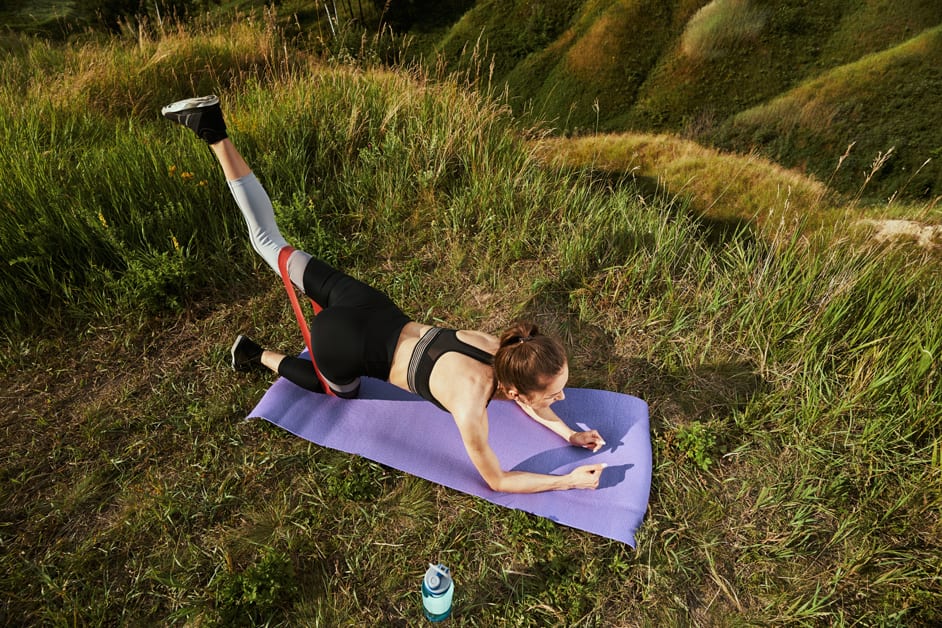Introduction
Dynamic stretching is an exercise that helps your joint move throughout its full range of motion. It increases mobility and flexibility. Different from static stretching, dynamic stretching employs controlled, rhythmic movements.
Dynamic stretching is great to add to a strength-training program to improve knee health and reduce the chance of injuries. It helps with flexibility, coordination, and strengthens muscles around the knees. Plus, dynamic stretching may reduce joint stiffness due to long or repeated movements. Adding dynamic stretches to your routine improves your performance and helps you stay injury-free.
Benefits of Dynamic Stretching
Dynamic stretching has many advantages. It helps your body get ready for activity, and reduces the chances of getting hurt. It helps improve the range of motion for your muscles and joints, increases blood flow, and lowers knee pain risks.
Here are some of its benefits and how to incorporate it into a weightlifting routine:
Improved Range of Motion
Dynamic stretching can help you improve range of motion, strength, and athletic performance. It involves movement and should be done as part of a warm-up or cool down. This type of stretching minimizes stress on joints and helps avoid injury from overtraining.
Dynamic stretching promotes correct form in lifting exercises. This helps with posture and gives more power for movement. It also increases coordination between muscles, giving a sense of control. Plus, it increases flexibility. This allows more powerful muscular contractions which reduce strain on joints during sports activities like soccer, basketball, or volleyball.
Dynamic stretching also helps reduce soreness after workouts. It stretches the connective tissue, allowing for longer aerobic activities without cramps or strains. Doing regular dynamic stretches and yoga can help with joint health and muscle stability, minimizing risk factors.
Improved Performance
Dynamic stretching is a form of stretching that involves moving joints and muscles through their full range of motion. The purpose is to increase strength, flexibility, and coordination while avoiding injury. It can also enhance performance in any sport.
Dynamic stretches are better than static stretches or traditional warm-ups. They help improve joint mobility, balance, coordination, and power production. This allows athletes to reach peak performance levels in activities that need quick movements, such as sprints or high jumps.
Regular dynamic stretching reduces the risk of musculoskeletal injury. It helps warm up muscles, reduce post-workout cramping, and limit overall fatigue. It is especially useful for those who engage in high-intensity sports. Dynamic stretching should be part of any strength training routine that focuses on knee health and peak performance.
Reduced Risk of Injury
Dynamic stretching helps reduce injury risks during physical activity. It increases flexibility and range of motion, which reduces the chances of pulling a muscle. These stretches also involve active movements to improve coordination, balance, and proprioception. This helps with technique when strength training or playing sports and decreases stress on the knee joint.
It also loosens muscles and ligaments around the knee joint so they are better prepared for impact. Dynamic stretching also improves balance by engaging multiple muscles around the joint – preventing misalignment and shifting in the knee joint.
Dynamic Stretching Techniques
Dynamic stretching is a type of stretching that involves moving your body parts. It increases your range of motion and helps you become more flexible. It is great for strengthening your joints, especially your knees.
Here are some techniques – add them to your strength training!
- Dynamic stretching techniques
Ankle Rolls
Dynamic ankle rolls are great for strength training. They help improve range of motion and protect against knee injury.
- Stand with your feet hip-width apart.
- Put weight on one foot and rotate the ankle joint, drawing circles in both directions for 10 secs.
- Switch to the other foot and repeat.
- Don’t shift too much weight onto the standing leg. Remain upright to get maximum benefit from each set.
Knee Circles
Knee circles are a form of dynamic stretching. They are useful for people who spend many hours sitting or doing sedentary activities. This exercise helps to increase the range of motion in the hips and knees, which is beneficial for joint health.
To do knee circles, stand with feet wider than hip-width apart. Bend your knees and extend your arms out, palms down. Move one knee in a small circle 15-20 times in one direction. Then repeat with the opposite knee. Keep your hips still. If it’s hard to do this, switch legs after 10 reps. To make it more challenging, widen or narrow your stance as you do the stretch.
Don’t overexert yourself when doing dynamic stretches. Take breaks and listen to your body for signs that it needs a rest. Include dynamic stretches in your strength training routine. This can help improve mobility and reduce the risk of injury – and improve joint health!
Quadriceps Pulses
Quadriceps pulses are a dynamic stretching technique to improve flexibility in the legs and hips. These muscles are located near your hip joint. They can get tight due to overuse, bad posture, or activities like running, squats and cycling. Stretching quads helps to increase range of motion and flexibility. It also reduces pain and discomfort caused by tightness.
For the quadriceps pulses exercise stand or sit comfortably. Lift one leg so the top of your thigh is perpendicular with the ground. Hold for 3-5 seconds, then slowly release back down. Repeat 8-12 times on each leg. Do this for three sets or until you feel increased mobility. As you progress, try moving faster with each pulse, still keeping proper form.
Hip Flexor and Glute Activation
Dynamic stretching is active movements of the hips and glutes to increase flexibility and range of motion. Here are popular moves for hip flexor and glute activation. Do each one slowly and controlled, 10 times on each side.
- Hip Flexor Stretch: Start in a standing position. Shift your weight onto one leg and bring back knee to the front foot. Bend from the hips and feel a gentle stretch in the back leg. Hold for 6-8 breaths and go back to beginning.
- Single Leg Glute Bridge: Lie down. One knee up and opposite ankle on top of bent knee. Lift hips off the ground with heel as platform. Make a straight line from shoulder to knee. Squeeze glutes at peak. Then lower to start and repeat 10 times. Change sides.
Calf Raises
Calf raises are an awesome stretching trick to protect your knees during strength training. Plus, they help with flexibility and hip mobility. Tack them onto your warm-up or cooldown routine!
- Position your feet shoulder-width apart.
- Lift onto the balls of your feet, then slowly lower back down. You can press into a wall or rail for support. Keep your weight balanced between both feet. Good posture is key – back straight, shoulders relaxed.
Aim to do 10 reps or 1 set of 20 seconds with each leg. Mix it up by adding weights, doing static holds at various heights, or alternating legs with no rest between reps.
To keep your knees stable, your thighs, hips and abs all need to work together. Do calf raises to help with balance and steer clear of injury!
Incorporating Dynamic Stretching into Your Strength Training Routine
Dynamic stretching is a great addition to strength training! It’s an active form of stretching with slow and controlled movements – not static holds. It’s key for joint mobility, flexibility, and muscle coordination. All of these help prevent injuries. Plus, it optimizes performance.
Let’s talk about how to work dynamic stretching into your strength training for knee health:
Before Your Workout
Dynamic stretching before strength training is important. It helps to increase range of motion, reduce injury risk and prepare your muscles and nervous system for improved performance. Examples include:
- Walking lunges with lateral flexion
- Good Mornings with rotational press outs
- High knees on an elliptical trainer
- Lateral skater lunges
- Arm circles with hanging knee tucks
Follow good form and use partner/spotter cues. Allocate five minutes of warm up before the workout to mentally and physically prepare.
During Your Workout
Dynamic stretching is key at the start of strength training. It boosts joint flexibility, muscle strength and range of motion. Air squats to glute bridges, overhead lateral lunges, and walking lunges are some great dynamic stretches to warm up your joints.
Between sets, stay active with bodyweight exercises like burpees and jumping jacks, as well as high-knees and mountain climbers. This helps maintain blood flow and releases tension while you recover.
At the end, static stretches are important. They elongate muscles, which were broken down by intense training, and promote joint health. Dynamic stretches such as leg swings, hip circles, and reverse lunge-to-balances improve range of motion for everyday activities like running or jumping.
After Your Workout
After your workout, get some dynamic stretches in. This is different from static stretching. Instead of holding a position, go through a slow range of motion. Examples?
- Running on the spot
- Lunging with bent knees
- Doing squats
Move slow and controlled. Remain relaxed, but deliberate. Stop if you feel any pain. If you don’t pay attention to proper form, you can hurt yourself. Take extra caution when exercising the knee joint!
Conclusion
Dynamic stretching can help your knees. It increases flexibility & range of motion, reducing stress on joints & muscles. This helps improve agility and coordination, reinforcing good form with the right stabilizing muscles. Reduced tension & improved form mean less chance of injury, so you can get the most out of your workouts!
Frequently Asked Questions
Q: What is dynamic stretching?
A: Dynamic stretching involves active movements of the body, such as swinging your arms or legs, with the purpose of preparing your body for physical activity. It is contrasted with static stretching, which involves holding a single position for a period of time.
Q: How can dynamic stretching benefit my knee health?
A: Dynamic stretching can help improve your range of motion and flexibility, which can help prevent knee injuries during strenuous activities. It can also help improve your balance and coordination, which is important for performing strength training exercises safely and effectively.
Q: What dynamic stretching exercises can I incorporate into my strength training routine?
A: There are a variety of dynamic stretching exercises that can be incorporated into a strength training routine. Examples include leg swings, walking lunges, and skaters. It is important to focus on dynamic stretching exercises that involve the movements and muscles that you will be using during your strength training routine.





